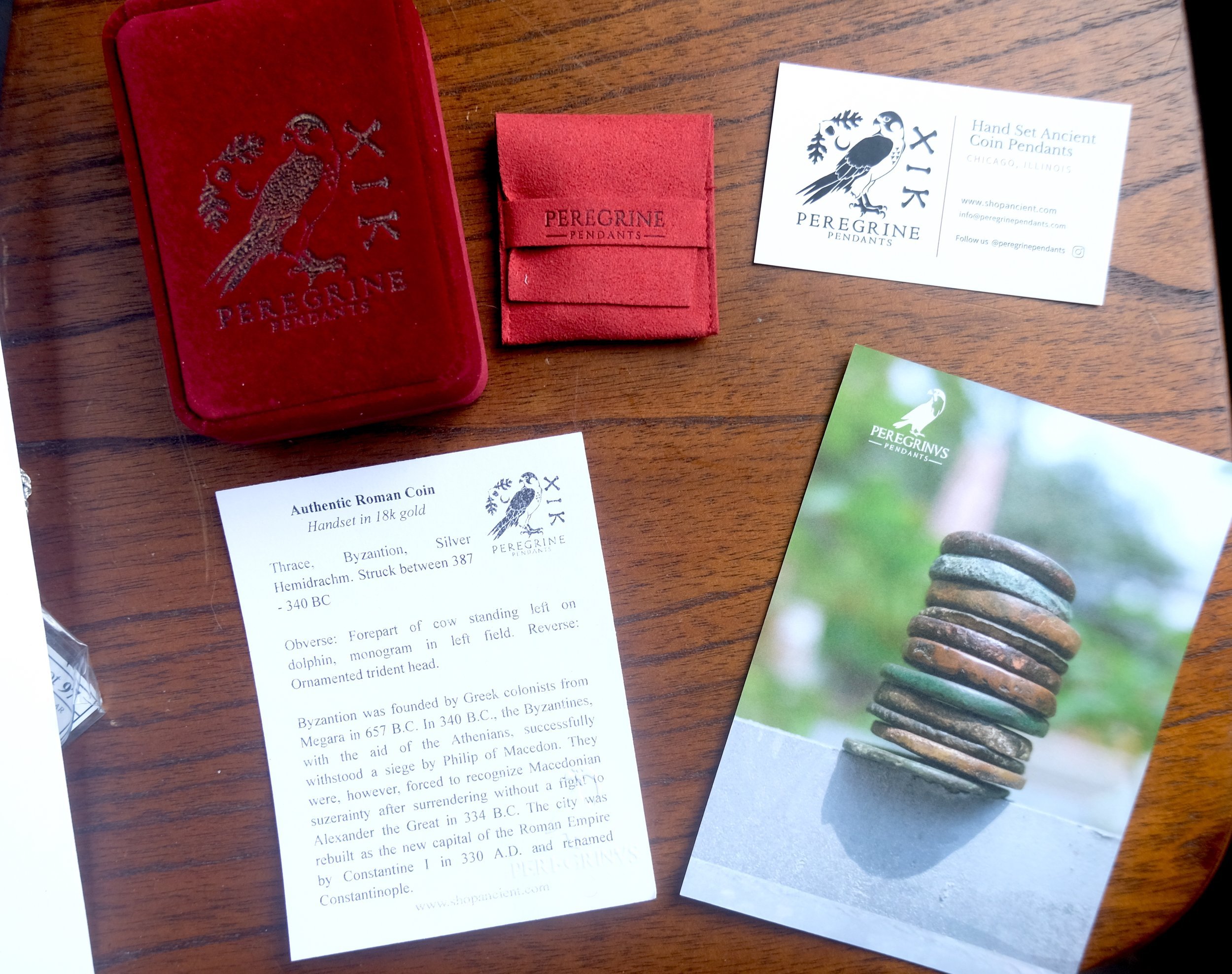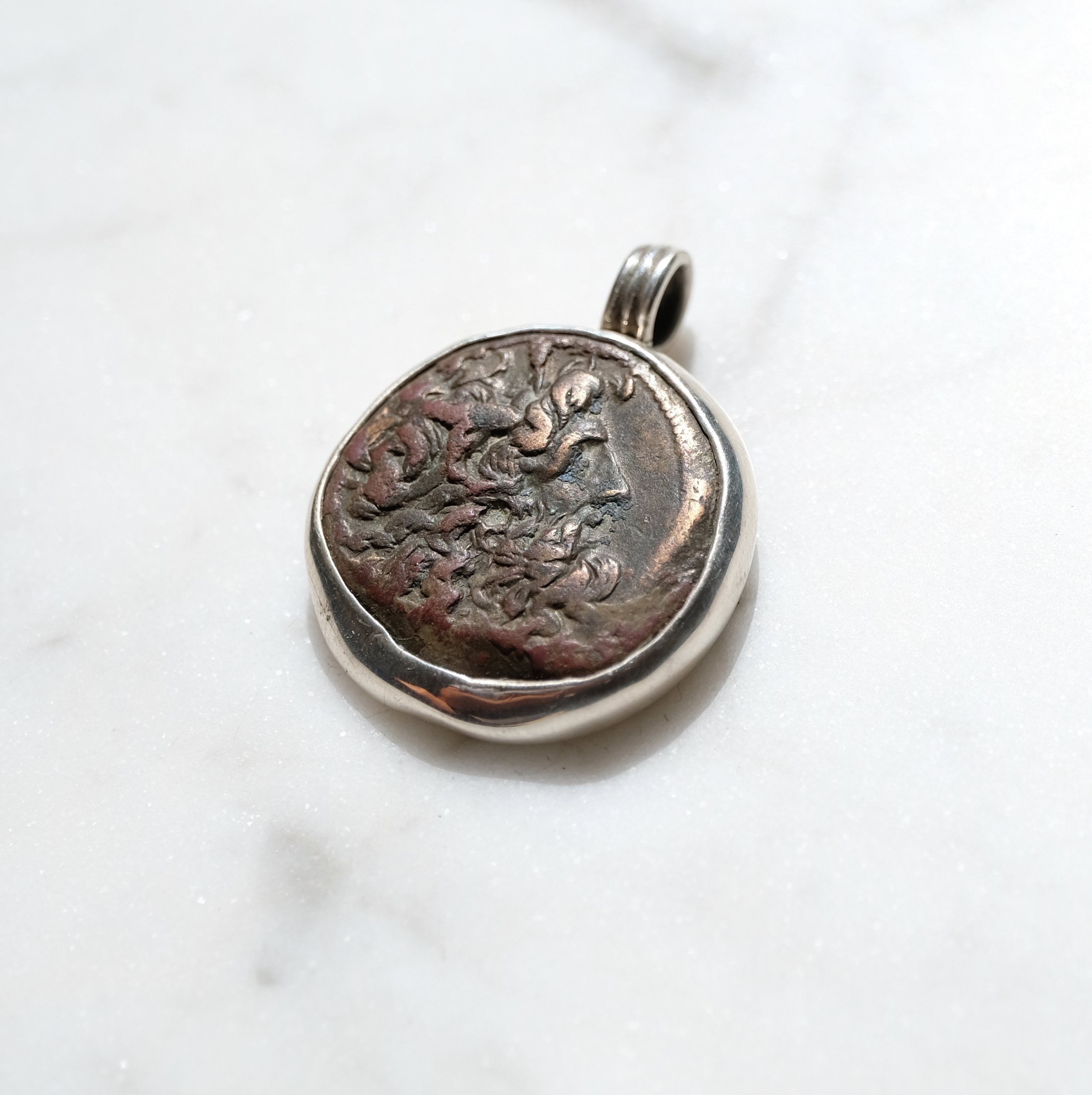 Image 1 of 5
Image 1 of 5

 Image 2 of 5
Image 2 of 5

 Image 3 of 5
Image 3 of 5

 Image 4 of 5
Image 4 of 5

 Image 5 of 5
Image 5 of 5






Phrygia. Apameia. Cistophoric / Snakes. (132 BCE, silver set)
Imagery that speaks to on the imagination, twice. This coin was purchased from a reputable German dealer. Note that it was quite large.
-- Coin information:
IONIA, Ephesos - silver tetradrachm
Obverse: cista mystica with serpent within ivy wreath
reverse: two serpents entwined around bow and quiver; Γ (date) to upper left, torch to right
Struck circa 180-67 BC (dated CY 3 (132/1 BC)
Ephesos, on the west coast of Anatolia, was one of the twelve cities of the Ionian League. It was famous for its Temple of Artemis, completed around 550 B.C., one of the Seven Wonders of the Ancient World. The cult image of the Ephesian goddess has a mummy-like body with the feet placed close together, is many-breasted, and from each of her hands hangs a long fillet with tassels at the ends. At her side stands a stag raising its head to the image of the goddess. The usual symbols of this nature-goddess are the torch, stag, and the bee. Coins of Ephesos most frequently depict a bee on the obverse. The high-priest of the temple of Artemis was called the King Bee, while the virgin priestesses were called honey-bees (Melissae). Ephesus was one of the seven churches of Asia cited in the Book of Revelation and the Gospel of John may have been written there. The image on the right is the beautiful facade of the Celsus library at Ephesos. It was the third largest library in the Roman Empire. The interior of the library and its contents were destroyed in a fire that resulted either from an earthquake or a Gothic invasion in 262 C.E., and the facade by an earthquake in the tenth or eleventh century. It lay in ruins for centuries until the façade was re-erected by archaeologists between 1970 and 1978. Click it to see a larger image.
—
To appreciate the pendant's size, the relief of the coin and the shape of the bail, see the picture showing the coin next to a US quarter (will post soon). The coin was carefully handled so no damage was done to it and meticulously set in a silver bezel, which was then hammered over the edge of both sides. This was then sanded and polished. This pendant is built to last.
This piece will come with certificate which guarantees authenticity and provides background information (listed above) .
Follow on Instagram
****
Why buy from us? I see a lot of pre-made bezels, that are made for modern coins passing as "handmade" jewelry. Each of our coins is carefully handset in a custom made bezel which takes time and skill.
Imagery that speaks to on the imagination, twice. This coin was purchased from a reputable German dealer. Note that it was quite large.
-- Coin information:
IONIA, Ephesos - silver tetradrachm
Obverse: cista mystica with serpent within ivy wreath
reverse: two serpents entwined around bow and quiver; Γ (date) to upper left, torch to right
Struck circa 180-67 BC (dated CY 3 (132/1 BC)
Ephesos, on the west coast of Anatolia, was one of the twelve cities of the Ionian League. It was famous for its Temple of Artemis, completed around 550 B.C., one of the Seven Wonders of the Ancient World. The cult image of the Ephesian goddess has a mummy-like body with the feet placed close together, is many-breasted, and from each of her hands hangs a long fillet with tassels at the ends. At her side stands a stag raising its head to the image of the goddess. The usual symbols of this nature-goddess are the torch, stag, and the bee. Coins of Ephesos most frequently depict a bee on the obverse. The high-priest of the temple of Artemis was called the King Bee, while the virgin priestesses were called honey-bees (Melissae). Ephesus was one of the seven churches of Asia cited in the Book of Revelation and the Gospel of John may have been written there. The image on the right is the beautiful facade of the Celsus library at Ephesos. It was the third largest library in the Roman Empire. The interior of the library and its contents were destroyed in a fire that resulted either from an earthquake or a Gothic invasion in 262 C.E., and the facade by an earthquake in the tenth or eleventh century. It lay in ruins for centuries until the façade was re-erected by archaeologists between 1970 and 1978. Click it to see a larger image.
—
To appreciate the pendant's size, the relief of the coin and the shape of the bail, see the picture showing the coin next to a US quarter (will post soon). The coin was carefully handled so no damage was done to it and meticulously set in a silver bezel, which was then hammered over the edge of both sides. This was then sanded and polished. This pendant is built to last.
This piece will come with certificate which guarantees authenticity and provides background information (listed above) .
Follow on Instagram
****
Why buy from us? I see a lot of pre-made bezels, that are made for modern coins passing as "handmade" jewelry. Each of our coins is carefully handset in a custom made bezel which takes time and skill.
Imagery that speaks to on the imagination, twice. This coin was purchased from a reputable German dealer. Note that it was quite large.
-- Coin information:
IONIA, Ephesos - silver tetradrachm
Obverse: cista mystica with serpent within ivy wreath
reverse: two serpents entwined around bow and quiver; Γ (date) to upper left, torch to right
Struck circa 180-67 BC (dated CY 3 (132/1 BC)
Ephesos, on the west coast of Anatolia, was one of the twelve cities of the Ionian League. It was famous for its Temple of Artemis, completed around 550 B.C., one of the Seven Wonders of the Ancient World. The cult image of the Ephesian goddess has a mummy-like body with the feet placed close together, is many-breasted, and from each of her hands hangs a long fillet with tassels at the ends. At her side stands a stag raising its head to the image of the goddess. The usual symbols of this nature-goddess are the torch, stag, and the bee. Coins of Ephesos most frequently depict a bee on the obverse. The high-priest of the temple of Artemis was called the King Bee, while the virgin priestesses were called honey-bees (Melissae). Ephesus was one of the seven churches of Asia cited in the Book of Revelation and the Gospel of John may have been written there. The image on the right is the beautiful facade of the Celsus library at Ephesos. It was the third largest library in the Roman Empire. The interior of the library and its contents were destroyed in a fire that resulted either from an earthquake or a Gothic invasion in 262 C.E., and the facade by an earthquake in the tenth or eleventh century. It lay in ruins for centuries until the façade was re-erected by archaeologists between 1970 and 1978. Click it to see a larger image.
—
To appreciate the pendant's size, the relief of the coin and the shape of the bail, see the picture showing the coin next to a US quarter (will post soon). The coin was carefully handled so no damage was done to it and meticulously set in a silver bezel, which was then hammered over the edge of both sides. This was then sanded and polished. This pendant is built to last.
This piece will come with certificate which guarantees authenticity and provides background information (listed above) .
Follow on Instagram
****
Why buy from us? I see a lot of pre-made bezels, that are made for modern coins passing as "handmade" jewelry. Each of our coins is carefully handset in a custom made bezel which takes time and skill.
You Might Also Like

























